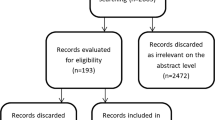Abstract
Purpose
Compare the recanalization rate of femoropopliteal occlusions between movable core wire guide (MG) and hydrophilic guidewire (HG).
Methods
Conventional PTA technique was used, followed by enclosed thrombolysis. The MG was used for all patients in the first 2 years, the HG in the following 2 years. Baseline characteristics were similar for the two groups of patients.
Results
Recanalization of 124 femoropopliteal occlusions was attempted. Technical success was achieved with the MG in 45 of 59 procedures; 42 procedures were clinically successful. Using the HG, technical success was achieved in 35 of 65 procedures; clinical success was achieved in 29 cases (p < 0.0048). At 1-year follow-up, 32 extremities improved after treatment with MG and 22 extremities after treatment with HG (p < 0.035).
Conclusion
The results suggest that the MG should be the first choice in recanalization of femoropopliteal occlusions.
Similar content being viewed by others
References
Leach KR, Kurisu Y, Carlson JE, Repa I, Epstein DH, Urness M, Sahatjian R, Hunter DW, Castaneda-Zuniga WR, Amplatz K (1990) Thrombogenicity of hydrophilically coated guide wires and catheters. Radiology 175:675–677
Jeans WD, Armstrong S, Cole SEA, Horrocks M, Baird RN (1990) Fate of patients undergoing transluminal angioplasty for lower-limb ischemia. Radiology 177:559–564
Tønnesen KH, Holstein P, Andersen E (1991) Femoropopliteal artery occlusions treated by percutaneous transluminal angioplasty and enclosed thrombolysis: Results in 55 patients. Eur J Vasc Surg 5:429–434
Tønnesen KH, Vinberg N, Folkenborg O (1992) Prolonged binding of radiolabeled recombinant tissue-type plasminogen activator after angioplasty and enclosed thrombolysis of the femoro-popliteal arteries. JVIR 3:627–632
Ad Hoc Committee on Reporting Standards, Society of Vascular Surgery/North American Chapter, International Society for Cardiovascular Surgery, Rutherford RB, Flanigan DP, Gupta SK, Johnston KW, Karmody A, Whittemore AD, Baker JD, Ernst CB (1986) Suggested standards for reports dealing with lower extremty ischemia. J Vasc Surg 4:80–94
Lammer J, Pilger E, Decrinis M, Quehenberger F, Klein GE, Stark G (1992) Pulsed eximer laser versus continuous-wave Nd: YAG laser versus conventional angioplasty of peripheral arterial occlusions: Prospective controlled randomized trial. Lancet 340:1183–1188
Author information
Authors and Affiliations
Rights and permissions
About this article
Cite this article
Tønnesen, K.H., Bülow, J., Holstein, P. et al. Comparison of efficacy in crossing femoropopliteal artery occlusions with movable core and hydrophilic guidewires. Cardiovasc Intervent Radiol 17, 319–322 (1994). https://doi.org/10.1007/BF00203950
Issue Date:
DOI: https://doi.org/10.1007/BF00203950




